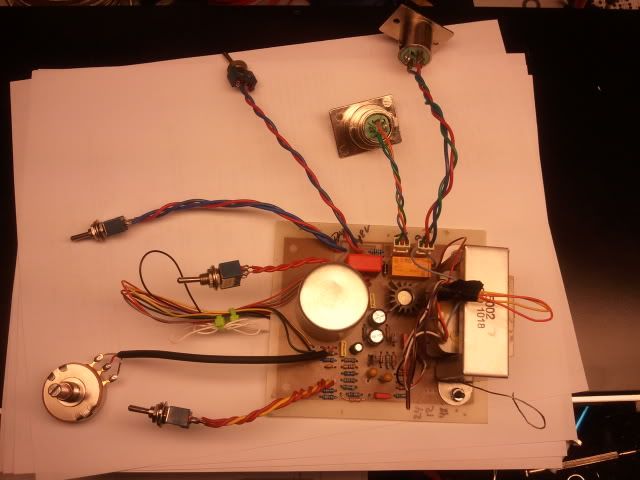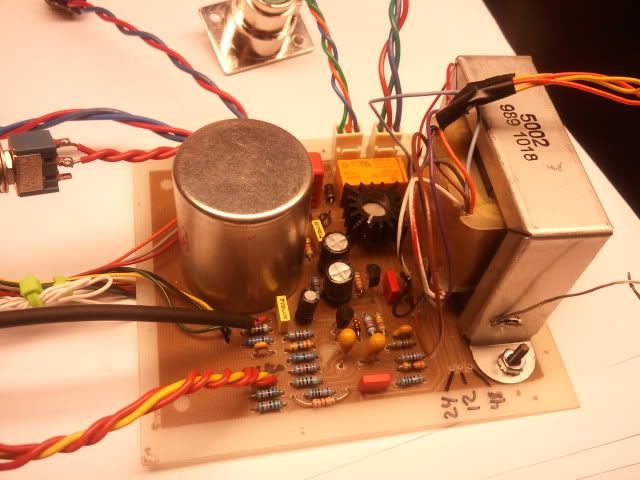Quote from Avedis hope he don't mind. Is interesting:
Hey, I read this and wanted to add something to it... next thing I know it's a few paragraphs...
One day I was at Brent's rummaging through some plastic storage boxes (I love rummaging - I'm a rummager) and saw these 1108 amps lined up like bars of gold. The transformers looked of good quality, especially the mic transformer on the input. I found a schematic and some documentation on the uses and specs, so I took it home to study. I tapped the input transformer for a nice step up that added about 20 db's of gain (this is good because it imparts a character), it had adequate amp gain with low noise, and had another tranny in the output... all the right ingredients, I thought.
With the transformers step up and the gain of the amp, there had to be a reciprocal PAD on the input. After some testing I put a 20 db pad on there that matched the input impedance well and did a small mod on the amp to bring it in the gain range that was needed. Like other things I've worked on, I wanted to bring the 1108 to it's normal state of operation and meet the spec they were designed for; otherwise, a mistake in racking them up and you'll be hearing the character of the mistake more than the character of the amp. Some listening tests and realized it sounded good... different than what I'd heard in other pre's. It didn't have the huge low end I've been use to with other pre's but the mid and especially the top end of this thing was unbelievable. Equally interesting, from a technical point of view, is that a frequency response graph does not show any strong ringing or overshoot in the top end. hmm..
Because of the class A circuit, when you get to the max output (about +25dbu), the amp goes into asymmetrical clipping, meaning one of the waveforms clip but not the other which produces even-order harmonics. I'm not sure how it sounds because I never got to it (the power amp I had at the time clipped before many of these preamp did!) but you can put a simple three resistor pad inside an XLR to pad it down, say 15 db's, which may get it in the clipping range for you to use. This is cheap and easy and works better than potentiometer type attenuators, since pots have a tolerance and don't track perfectly at all points in reference to audio ground so you can kiss CMRR goodbye. Two series and one shunt resistor is all you need and you can solder it right in your XLR and label it, but you have to use metal-film resistors to maintain good noise rejection. Maybe I could put up a few pad examples on my site when I get a chance.
Anyway, I built the first prototype and took it in to Brent's for the rest to be prepared the same way.
I'd known that these amps came from Van Halen's old console when an API was put in so I talked to the great VH engineer Donn Landee about some photography work (he's an amazing photographer, too) and asked him a few questions about the old Universal Audio board. He gave me all the details on how they were used and how he had to use a makeshift PAD on them also, and was kind enough to sent some old photos of the board so I could see about getting that light tan color in power-coat finish. Growing up on VH in the 80's, and having an older brother yell at me for not handling the records to his liking, it was great to be doing this and talking to Donn Landee.
Since all that what was needed was a gain pot, PAD, phantom, and phase, I thought I'd keep it simple and easy for everyone and use the same faceplate the 312/312A had, but use a deeper chassis as the 1108's had fairly long frames. It also runs on 24vdc, so the already available BA/Neve type remote supply would work well. When they were done, one was sent off to Donn to photograph and he opened it up and liked what he saw and took some photos of the insides... but mentioned that they were mistakenly screened as UREI instead of Universal Audio. That was my fault... daammmitttt!
Avedis




